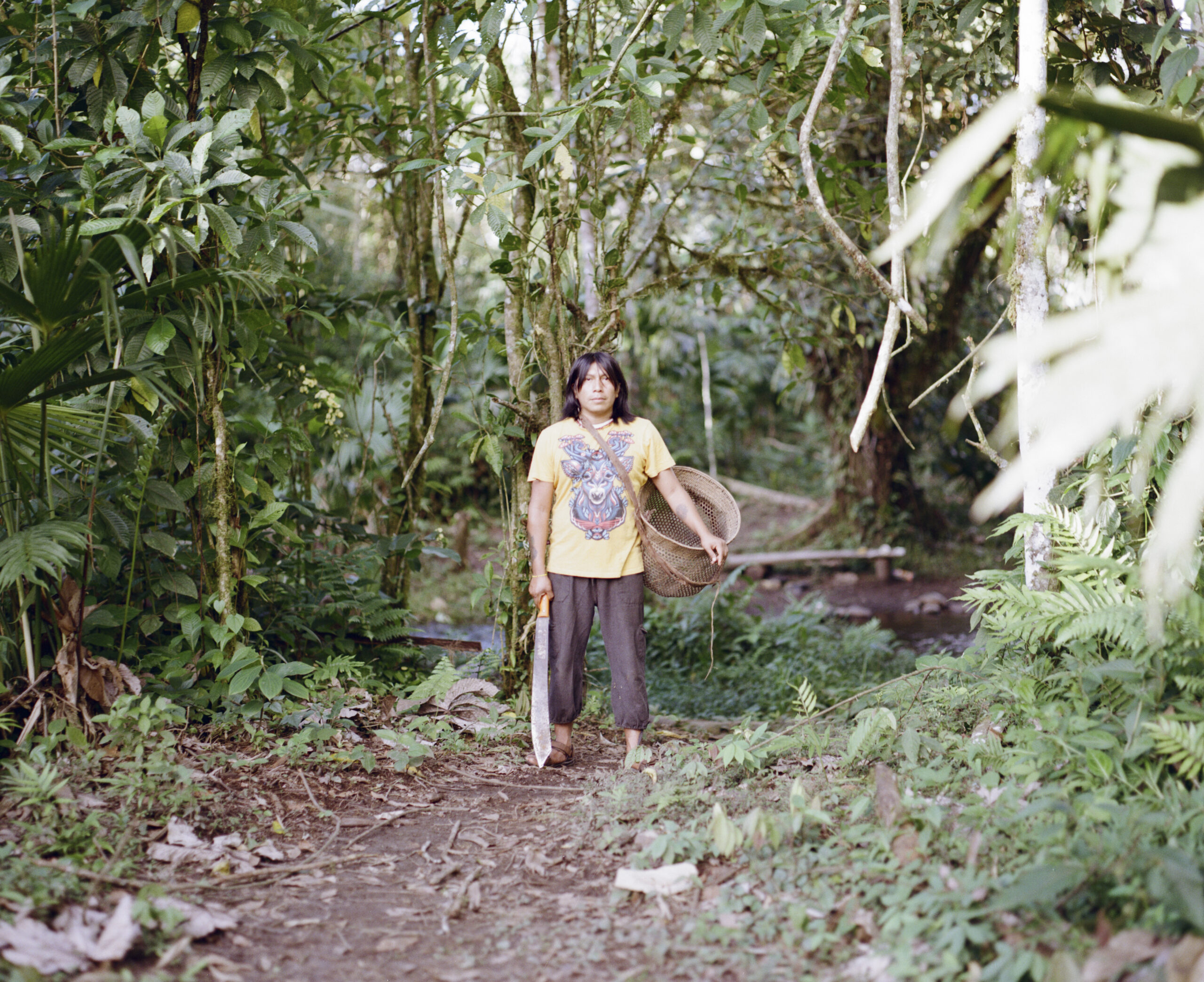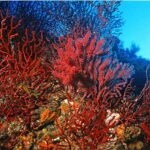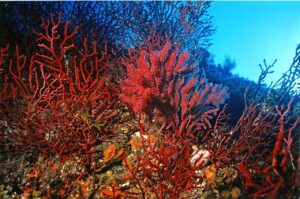Yanda Montahuano Ushigua often wakes at 3:30 in the morning to drink Wayusa and discuss his dreams.

“I had dreams, visions of the elders, where they gave me spears, and they asked me to throw those spears into the world. And so I would throw them, and the spears would fly like lights into the forest and everywhere. And when I started working with radio, I started to gather an audience. Many people listened to me and my program in Puyo, because my program was unique, funny and new, they weren’t listening to a professional radio broadcaster with a seductive voice, they were listening to a boy telling the story of the first Sapara man, and of how the Saparas came to each of the lands.”
While Yanda often shares his dreams, he also follows them.
“My dreams pushed me to explore cinema. I met a German guy who invited me to participate in a documentary, so I helped out a bit and liked it. We made several trips along the Amazon Basin through the Pastaza River. We traveled to Brazil through the rivers, getting to know the cultures, their ways of life. And while on the trips, I always carried tobacco with me, and as we traveled I smoked and thought about my family. I thought about how I wanted to contribute something from our knowledge.”
Yanda’s Father is Kichwa and his Mother is Sapara.
“One day, I was in the jungle here in Sapara, riding on a canoe, and I saw a man in the shade. The sun was shining very bright, and he was pushing and steering the canoe. And I saw his shadow in the River, and the tawna’s shadow.”
Tawna is a Kichwan word that refers to a stick that is used to move a canoe, like an oar.
“And so I saw the man in the shade in the river. His shadow sailing with the tawna, steering with the tawna. And that’s when it occurred to me, I mean, we must tell a story from within ourselves, we have to start empowering ourselves. And I saw this stick, which steers the canoe to get to our destinations and I said, this stick must be transformed to start steering gazes. And what’s going to start steering gazes? A camera.”
With his sister Sani Montahuano Ushiua — along with Miguel Imbaquingo, Lucía Villaruel and Boloh Miranda Izquierdo — Yanda founded the multicultural film organisation Tawna.
“It came to me, in that shadow, in that dream the idea of founding Tawna connected. First I made a documentary with the help of some friends, and that helped me explore a bit more… I met another indigenous filmmaker from Ortavalo. He helped me shoot the documentary called ‘Píatua Resiste’. And so that’s how the team started to come together. There were eight of us in total. My sister also joined us in that process of looking for the team that would become Tawna, the filming team, the team that helps us to develop the projects, to put to script the dreams that we had.
“In 2021, Tawna was born in the heart of the jungle. Tawna has lands, it has a tongue, a language, it has guardians of the forest, it has a vision. And that guide, the Tawna, which is us, we are trying to make our work have a vision of construction, that our films help to build something, that through our movies people learn to love the jungle, because it’s dwindling rapidly and there’s very little left.”
More and more, Tawna is led by Yanda’s sister Sani, who was seated opposite her brother when I met them on their family’s land, near Puyo in Ecuador.

“Tawna’s vision is to tell our stories from within, from our point of view, the indigenous point of view, and also a young point of view. They say that we are the future generation, and it’s us who have to leave our footprints for the children that are coming. We tell the stories that our grandparents, our mothers, told us. As Tawna, we also provide support to the struggles of our peoples, to everything that is happening in the Amazon.”
In a short amount of time, Tawna has already produced the films “Shun”, “Tuku”, “Tsitsanu”, and the recently completed documentary “Allpamanda”. They are about to start filming a new documentary called “Uyaua Escúchame”.
“Through Tawna… we have to tell the world that the Amazon is dwindling. We have to be aware of ourselves, we have to plant, to build, to have something for our children, our kids, our nieces and nephews, children who have not been born yet, for them to have something to plant, something to breathe, something to take care of in this land. Without this land, without planting anything… If we destroy everything, where will our children live? In which tree will they play in? What fruit are they going to eat? With what achiote are they going to paint themselves with? So, we, through Tawna, have to make these stories visible, stories like the history of the achiote, the story behind the river, the stories of our grandparents’ struggle and how they defended our lands, our homes, and also our spirits. Without the balance from the spirits of the animals, we wouldn’t be here.
“We are the voices and the eyes of the jungle. If we don’t dream for them, they won’t create new beings for us, because each day in the jungle new beings are being born to protect us, to help maintain the Earth’s balance. So as Tawna we have come to share our stories from our perspective, from the Amazon’s perspective, from the jungle’s perspective.”
When Sani shared these words, it sparked Yanda to share more.
“Tawna has territory, has a language, has history, has a nature beyond being a collective. There is a generation behind us, there is a generation in history that is also going extinct, like my Sapara culture, since there are so few Sapara people left. Nowadays we have become empowered with technology, but that work has been collective… We are building from a space of diversity to show the world that if we combine dreams, combine colors, we can move forward, since in this system we are very very very oppressed, from the oil companies, mining companies, hydroelectric companies and the highways that are trying to get into the heart of the jungle. But here we are, with our voices and with our families. This is the dream of Itia and Tawna. It’s a dream from within the jungle, from here, to the world.”
Itia refers to Itia Mamá Minga, a project that Yanda, Sani and their sister Mukutsawa are all focused on. It was at Itia where we shared these stories. Mukutsawa was sitting next to Sani and she spoke of the vision behind the project.

“With my siblings, we came together to plant this dream that my Mother left us. A dream we have been working on, little by little, building it from the ground up. This place, Itia, which in our Sapara language means house, is a place where anybody from any place in the world can arrive and feel at home. Here we share everything that my Mother taught us — how to identify the plants, how they are used, the fruit that grows here — and to plant all of that and to make a jungle here, to bring the jungle here beside the Pastaza (River).”
Their Mother had a vision for the land where Itia Mamá Minga is located. Sadly she passed away before she was able to bring her dream into the physical world, so Yanda, Sani and Mukutsawa focused their lives on honouring their Mother and her vision. Yanda shared this vision.
“Itia means house, Mamá is my Mother, and Minga means collective work for collective purpose, because we always have a Minga to build a house, to gather wood, to bring seeds and plant them, we have always practiced Mingas for collective work. This work has been going on for a very long time, and this collective work is what we practice today. My Mother is no longer with us, she is a memory and the beautiful thing is that she left us with knowledge. How to choose which plant to consume, which plant is used for dreaming, for curing purposes, and we do that here.
“Right now we are on the banks of the Pastaza River. We are very close to the city of Puyo… Here in this space, in this farm we have over 40 acres where we are building a living space close to the city, so that the people from the city can come to get to know this space, learn to share, drink Wayusa and drink Chirikaspi, and walk by the Pastaza and breathe. It is a space like a greenhouse where we, this generation, the new generation, want to take care of the land. We don’t want to sell anything, we want to keep this forest, which is an island. On this island we want to maintain the habitat intact here, planting and also reforesting. Itia allows us to create more things… Because if we don’t have this space, if we don’t take care of it, if we don’t build it up… Well, our neighbors have already cut down all of the forests, they have killed everything, they have no jungle.”

Sani contextualised the vision of Itia Mamá Minga by speaking of the wider community.
“We, the Sapara people, are now at risk of extinction. We have less than 500 people, our language is disappearing. We are located in Pastaza, and we have 23 communities… The people are practicing the language so that it doesn’t disappear. Through song, some like to write. My younger sister writes, she’s practicing our language through writing poetry.
“We, the Saparas, we come from a monkey, the red howler monkey. In the month of May, in the time of the monkey, we transform ourselves, we paint our hair red. Our legends tell us that there once was a monkey that went down to the Conambo River to drink water, and he became a man. And so did another monkey, and she became a woman. And from the union of this couple the first Sapara man was born, Tsitsanu. Then he traveled through the jungle and became very wise. When he returned home, he became a very powerful man. And that’s where we come from, we the Saparas, we came here. We are a culture that dreams, we have great dreamers. We dream in order to be able to go on through our day. We dream to live, and live to dream too. So today we are at risk of extinction, and we do not want to disappear. This is why we tell our stories and why we want people to come and meet us. We continue to build so that they can’t come to destroy us.”
These words sparked Yanda.
“We have been dreaming. As we sleep, we travel, we look at images, we connect with the spirits, our ancestors give us messages, we talk with our Mother who is not with us in the physical sense. I always say that dreams and cinema should be linked, they should connect to be able to tell a profound story, about us, about spirits that talk. And we are their voices, the voices of the plants, of the rivers, of our ancestors, of the generations. And through Itia we want to leave this legacy, from our youth. Creating, building and dreaming, and we are doing all of that through Tawna and Itia, from our space, where we are dreaming of new projects. Little by little we are moving forward but bringing knowledge to the world.”
Mukutsawa echoed her brother’s words.
“What inspires me the most from everything that we’ve been building with my siblings, is that everyone, everybody, carries a piece of jungle inside of their hearts. And we’re more conscious of everything we do, of everything we consume. We’re aware that we’re not the centre of this universe, on the contrary, we are the complement of everything, of all of the Pacha Mama, of all of this beautiful jungle that we have here. And I believe that if we keep following this dream, we will all have the jungle, alive in our hearts, we will be more connected to our roots, we will know who we are and where our path is taking us, and the jungle will be everywhere.”

Towards the end of our conversation, I asked how people can support the work that they are doing, Sani responded.
“Well, as I was saying, we’re told that we’re the future generations, we’re here for the children that are to come… For me, my heart is filled with the energy to continue to build more things for the young people to come, since we are here living because of our parents in these territories, but we’re still being threatened by the oil companies.
“We, as Tawna, are looking for support, because we are a non-profit foundation. We want support for our future projects, and for equipment as well, if we’re going to shoot in the field. As my brother Yanda said, Tawna has its own territory, we have a stage, a stage where we can film. This whole jungle is Tawna’s stage, where we shoot…
“Technology can either destroy us or, as we have done with it, it can help us build for future generations and for ourselves. Because we are going to grow old, and I want to grow old eating fruits from a tree that I have planted. And so Tawna also has a small filmmaking school, in which we can build new dreamers. There’s many different types of dreamers: musicians, painters, cameramen, photographers, storytellers, craftsmen, ceramics, clothing… So we are the ones who help young people fulfill their dreams, and bring out that knowledge that they have inside, with this technology, which is a very important tool that highlights the struggles of our peoples…
“So that’s Tawna’s vision for the future, to continue building new dreamers and continue telling stories and following the struggles of our people. Because right now, a very big struggle is coming, as oil companies are entering with more force, the logging companies, mining companies, and also the highways are penetrating with a lot of strength. If highways manage to enter our communities, there will be no more communities. There will be destruction and there will be exploitation. And so as Tawna we also follow this so that the world can see that they’re destroying us, they’re killing our house, our home.”
And if their home is destroyed, our collective home will be destroyed with it.
Anton Rivette is a writer and photographer. He leads storytelling at eco-nnect.













